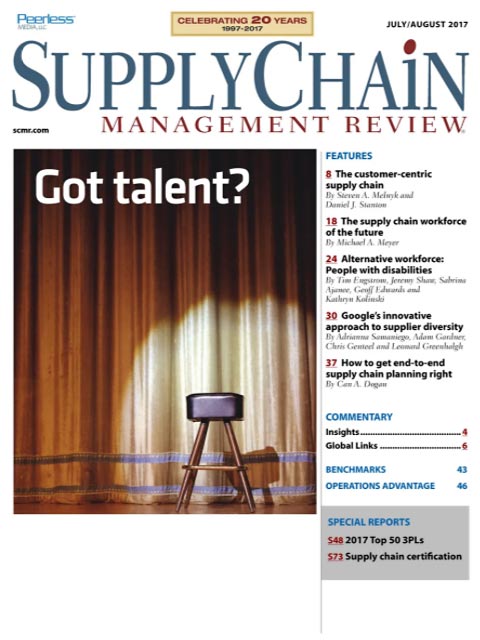Sorry, but your login has failed. Please recheck your login information and resubmit. If your subscription has expired, renew here.
July-August 2017
A few years ago, a Harvard Business Review cover posed the question: What’s the secret to winning in the global economy? The answer: Talent. Browse this issue archive.Need Help? Contact customer service 847-559-7581 More options
Digital supply chains, smart factories, Industry 4.0: However you describe the change upon us, the key point is just that—a change is upon us. An exponential change, at that. Klaus Schwab, founder and executive chairman of the World Economic Forum, refers to the change as the “Fourth Industrial Revolution.” To understand its implications, it is helpful to review the three prior revolutions. The First Industrial Revolution, which began around 1760, refers to a transition from manual to mechanized work, particularly though water and steam power. The Second Industrial Revolution, beginning in the later third of the 19th century, saw the advent of mass production, the growth of the steel and oil industries and electrification. Almost 100 years later, the 1950s saw the beginnings of the Third Industrial Revolution with the transition from analog to digital technologies.
In the 2010s we find ourselves in the midst of a Fourth Industrial Revolution. In it we see not only advances in science and biotechnology but also the cyber-physical systems of smart factories and the end-to-end value chains that encompass everything from raw-material extraction to conversion to distribution to use and reintegration. And whereas prior revolutions tended to be inter-generational, allowing successive generations to absorb and adapt to the changes, the pace of the Fourth Industrial Revolution will be intra-generational, with compelling new opportunities for sustainable prosperity.
But, there are challenges. Technology breakthroughs in areas such as mobile connectivity, artificial intelligence, the Internet of Things, robotics, 3D printing, biotechnology, genetic engineering, nanotechnology and advanced materials, to name a few, are radically transforming global production systems, from the individual worker on the factory floor to the globally distributed networks of suppliers and manufacturers that characterize today’s typical supply chain.

This complete article is available to subscribers only.
Log in now for full access or start your PLUS+ subscription for instant access.
SC
MR
Sorry, but your login has failed. Please recheck your login information and resubmit. If your subscription has expired, renew here.
July-August 2017
A few years ago, a Harvard Business Review cover posed the question: What’s the secret to winning in the global economy? The answer: Talent. Browse this issue archive. Access your online digital edition. Download a PDF file of the July-August 2017 issue.Digital supply chains, smart factories, Industry 4.0: However you describe the change upon us, the key point is just that—a change is upon us. An exponential change, at that. Klaus Schwab, founder and executive chairman of the World Economic Forum, refers to the change as the “Fourth Industrial Revolution.” To understand its implications, it is helpful to review the three prior revolutions. The First Industrial Revolution, which began around 1760, refers to a transition from manual to mechanized work, particularly though water and steam power. The Second Industrial Revolution, beginning in the later third of the 19th century, saw the advent of mass production, the growth of the steel and oil industries and electrification. Almost 100 years later, the 1950s saw the beginnings of the Third Industrial Revolution with the transition from analog to digital technologies.
In the 2010s we find ourselves in the midst of a Fourth Industrial Revolution. In it we see not only advances in science and biotechnology but also the cyber-physical systems of smart factories and the end-to-end value chains that encompass everything from raw-material extraction to conversion to distribution to use and reintegration. And whereas prior revolutions tended to be inter-generational, allowing successive generations to absorb and adapt to the changes, the pace of the Fourth Industrial Revolution will be intra-generational, with compelling new opportunities for sustainable prosperity.
But, there are challenges. Technology breakthroughs in areas such as mobile connectivity, artificial intelligence, the Internet of Things, robotics, 3D printing, biotechnology, genetic engineering, nanotechnology and advanced materials, to name a few, are radically transforming global production systems, from the individual worker on the factory floor to the globally distributed networks of suppliers and manufacturers that characterize today's typical supply chain.
SC
MR


Latest Supply Chain News
- Survey reveals strategies for addressing supply chain, logistics labor shortages
- Israel, Ukraine aid package to increase pressure on aerospace and defense supply chains
- How CPG brands can deliver on supplier diversity promises
- How S&OP provides the answer to in-demand products
- AI, virtual reality is bringing experiential learning into the modern age
- More News
Latest Podcast

 Explore
Explore
Software & Technology News
- Survey reveals strategies for addressing supply chain, logistics labor shortages
- AI, virtual reality is bringing experiential learning into the modern age
- Humanoid robots’ place in an intralogistics smart robot strategy
- Tips for CIOs to overcome technology talent acquisition troubles
- Game on: Rethinking change management for the digital era
- Predicting stockouts: Enhancing FMCG resilience through data-driven insights
- More Software & Technology
Latest Software & Technology Resources

Subscribe

Supply Chain Management Review delivers the best industry content.

Editors’ Picks





